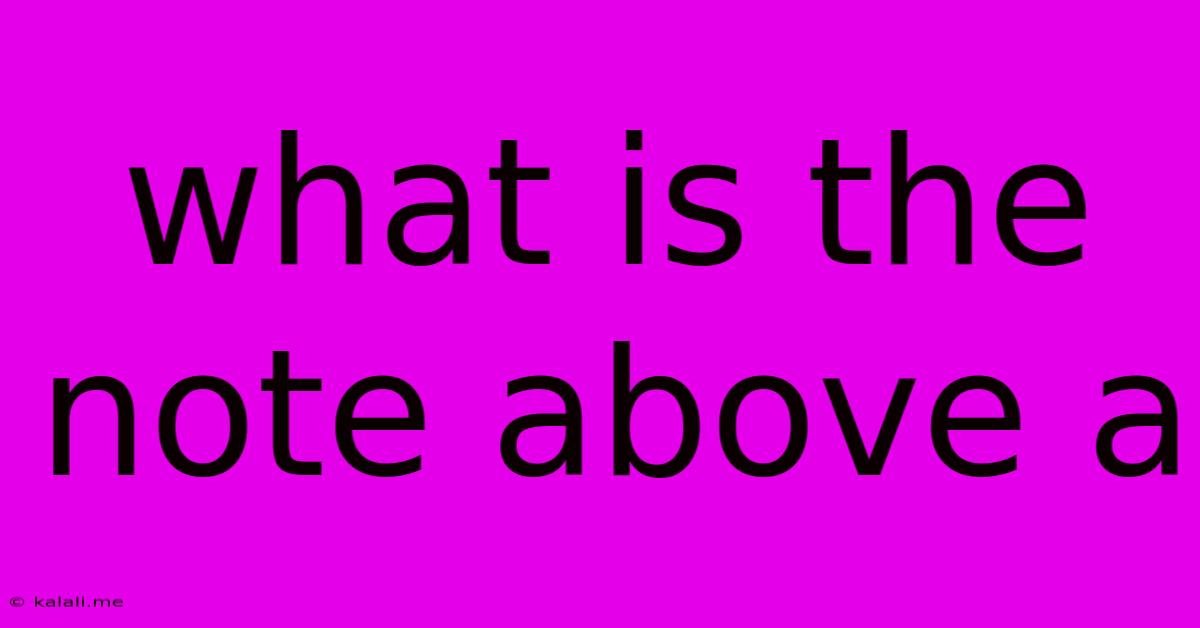What Is The Note Above A
Kalali
May 31, 2025 · 3 min read

Table of Contents
What is the Note Above A? Understanding Musical Intervals
This article will delve into the fascinating world of musical intervals, specifically focusing on the note above A. Understanding intervals is crucial for musicians of all levels, from beginners learning to read music to seasoned composers crafting complex melodies. We'll explore the various notes that can be found above A, depending on the musical key and context.
The Importance of Musical Intervals
Musical intervals represent the distance between two notes. They are fundamental to melody, harmony, and overall musical structure. Understanding intervals allows you to:
- Compose melodies: Knowing the intervallic relationships between notes helps create memorable and pleasing melodies.
- Understand harmony: Chords are built using specific intervals, and comprehending these intervals is essential for understanding chord progressions and harmony.
- Analyze music: Analyzing musical pieces becomes easier when you can identify the intervals used.
- Improvise: Knowing intervals enables improvisation and soloing by allowing you to predict and create pleasing melodic lines.
Determining the Note Above A: It Depends on the Context!
The note above A isn't a fixed note; it depends entirely on the musical key and scale being used. Here's a breakdown:
-
Major Scale: In a major scale, the interval from A to the next note is a major second. This means the note above A is B. This interval is a whole step.
-
Minor Scale: In a natural minor scale, the interval from A to the next note is a major second, making the note above A B. However, in a harmonic minor scale or melodic minor scale, the interval and the note above might differ slightly due to the alterations within those scales.
-
Chromatic Scale: The chromatic scale includes all twelve notes within an octave. In a chromatic scale, the note above A is A#/Bb. This is a half step.
Beyond the Immediate Note: Exploring Further Intervals
While the note immediately above A is often B, considering larger intervals provides a richer understanding:
- Major Third: A major third above A is C#.
- Perfect Fourth: A perfect fourth above A is D.
- Perfect Fifth: A perfect fifth above A is E.
- Major Sixth: A major sixth above A is F#.
- Major Seventh: A major seventh above A is G#.
- Octave: An octave above A is A.
Practical Application: How to Use This Knowledge
This information isn't just theoretical; it's practical for any musician:
- Sight-reading: Quickly identify the notes in a melody.
- Ear training: Recognize intervals when listening to music.
- Composition: Craft melodies and harmonies with intention.
- Improvisation: Create engaging and melodic solos.
Conclusion: Mastering Intervals for Musical Proficiency
Understanding the note above A, and intervals in general, is a cornerstone of musical understanding. It's not just about identifying the next note; it's about comprehending the relationships between notes, which unlocks a deeper appreciation and mastery of music. Whether you're a beginner or an experienced musician, continually refining your understanding of intervals will significantly enhance your musical abilities.
Latest Posts
Latest Posts
-
How To Tell If A Timing Belt Is Bad
Jun 01, 2025
-
Raised Beds Or Pots In Greenhouse
Jun 01, 2025
-
How To Read Sheet Music Piano Pdf
Jun 01, 2025
-
Incorrect Armature For Type Chain Rigs
Jun 01, 2025
-
Are Forever And Always The Same Thing
Jun 01, 2025
Related Post
Thank you for visiting our website which covers about What Is The Note Above A . We hope the information provided has been useful to you. Feel free to contact us if you have any questions or need further assistance. See you next time and don't miss to bookmark.